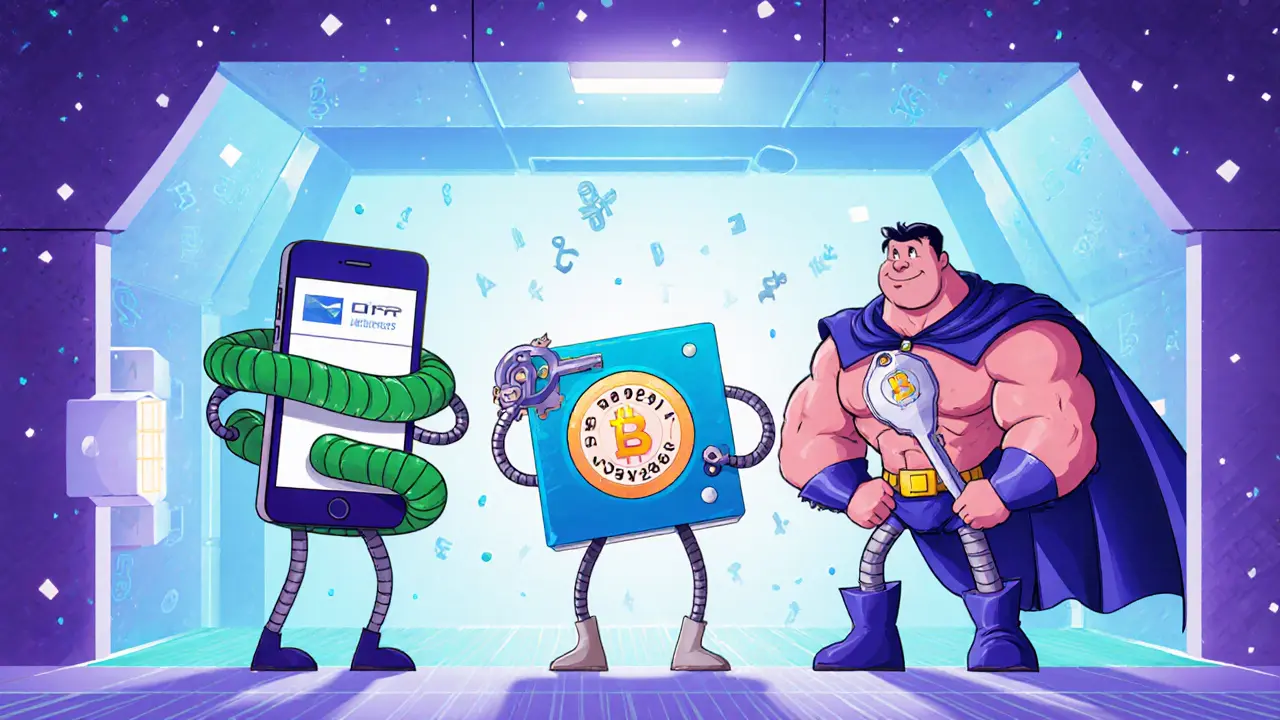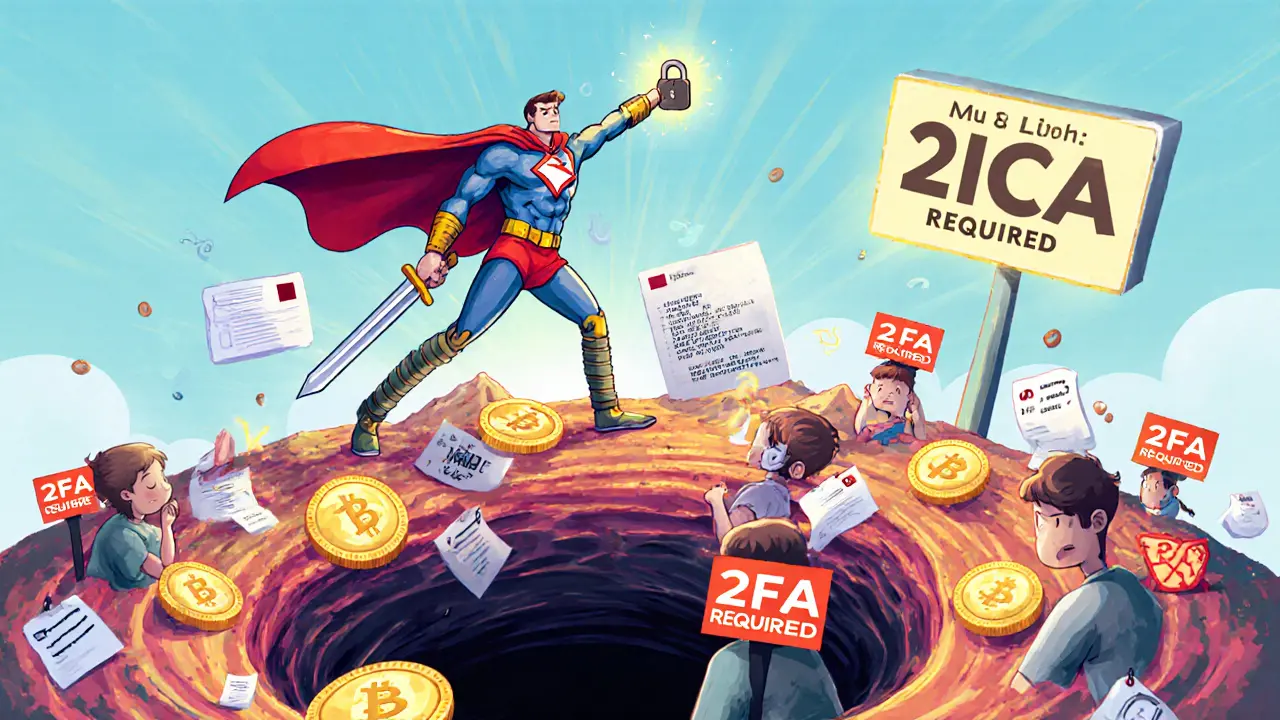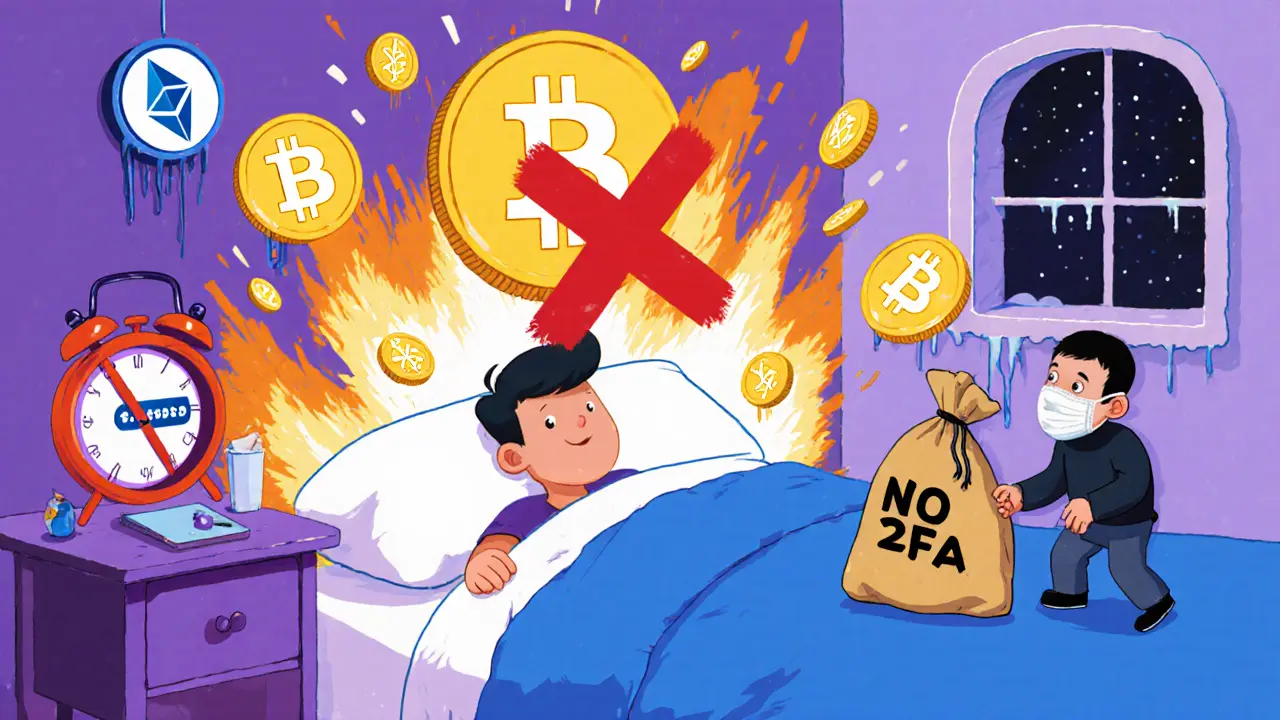2FA Security Comparison Tool
How Much Crypto Do You Hold?
2FA Methods Compared
SMS-Based
Highly vulnerable to SIM-swapping attacks. Over 2,300 crypto-related SIM-swap incidents reported in 2023.
Authenticator Apps
Blocks 98.7% of account takeovers. Generates time-based codes that refresh every 30 seconds.
Hardware Tokens
Nearly impossible to hack remotely. Stops 100% of phishing attacks when used correctly.
Your Recommended 2FA Method
Select your crypto holdings value to see your recommended 2FA method.
Imagine this: you wake up to a notification that your entire crypto portfolio-$50,000 in Bitcoin and Ethereum-is gone. No warning. No reversal. Just empty wallets. You didn’t get phished. You didn’t click a bad link. Your password was strong. But someone still got in. How? Because you only had one layer of protection. That’s the reality of crypto without 2FA.
What 2FA Actually Does for Your Crypto
Two-Factor Authentication (2FA) isn’t just a checkbox you tick during signup. It’s a second lock on your digital vault. While your password is something you know, 2FA adds something you have-like a code from your phone or a physical key. Without both, access is blocked. In traditional banking, if someone steals your login, the bank can freeze the transaction. In crypto? Once a transaction is on the blockchain, it’s final. No chargebacks. No customer service rescue. That’s why 2FA isn’t optional-it’s the last line of defense.Why Passwords Alone Are a Death Sentence
Passwords are weak. Even the best ones can be stolen in data breaches, guessed in brute-force attacks, or captured by keyloggers. In 2014, Mt. Gox lost 850,000 BTC because hackers used stolen credentials. Since then, exchanges have been hacked over 200 times, with over $3 billion stolen in total. Most of those breaches started with a compromised password. A 2023 Bitstamp study showed that accounts without 2FA were 99.2% more likely to be breached than those with it. That’s not a small risk. That’s a guarantee of loss if you’re not protected.The Three Types of 2FA-and Which One You Should Use
Not all 2FA is created equal. There are three main types, and your choice makes a huge difference.- SMS-based 2FA: Codes sent via text. Easy to set up. Also the most dangerous. Hackers can trick your mobile carrier into transferring your number (SIM swapping). The FBI recorded over 2,300 crypto-related SIM-swap attacks in 2023, costing victims $74 million.
- Authenticator apps: Apps like Google Authenticator, Authy, or Microsoft Authenticator generate time-based codes that refresh every 30 seconds. No internet needed. No phone number to hijack. Coinbase and Kraken report these block 98.7% of account takeovers. This is the sweet spot for most users-strong, simple, and reliable.
- Hardware tokens: Devices like YubiKey or Ledger Nano. You plug them in or tap them to log in. These are nearly impossible to hack remotely. Yubico says they stop 100% of phishing attacks when used correctly. They’re the gold standard for anyone holding more than $10,000 in crypto.
For everyday users, authenticator apps are the best balance. For serious holders, hardware tokens are non-negotiable. Avoid SMS at all costs if you have any real value in your wallet.

Real Stories: What Happens When You Skip 2FA
On Reddit’s r/CryptoCurrency, a thread titled “Lost $15k because I didn’t enable 2FA” had over 1,200 upvotes and 200 comments. One user, u/CryptoNewbie2023, said: “I thought my strong password was enough. Someone brute-forced it. My Binance account was drained in 8 minutes.” Another user on Trustpilot wrote: “I got locked out of my account because I lost my phone. But at least I had my recovery codes. I know someone who didn’t-and lost everything.” These aren’t rare cases. Coinbase’s 2023 report found that 18.7% of recovery requests came from people who lost access to their 2FA device. That’s almost 1 in 5. But here’s the flip side: users who use 2FA report blocked login attempts nearly every week. One person on Reddit said, “I got a notification that someone tried to log in from Nigeria. My 2FA code didn’t match. They got nowhere. That’s why I don’t sleep without it on.”How to Set Up 2FA the Right Way
Setting up 2FA takes less than three minutes. But doing it wrong can lock you out forever. Here’s how to do it right:- Use an authenticator app, not SMS. Download Authy or Google Authenticator on your phone.
- When prompted by your exchange (Coinbase, Binance, Kraken), scan the QR code with the app.
- Write down the 12- to 24-character recovery codes. Don’t screenshot them. Don’t store them in your email. Write them on paper and keep them in two separate safe places-a fireproof safe at home and a trusted family member’s house.
- Test the setup. Log out, then log back in using the code from your app. Make sure it works.
- If you’re holding more than $10,000, buy a YubiKey or similar hardware token. Plug it in during login. That’s it.
Pro tip: Use Authy instead of Google Authenticator if you use multiple devices. Authy syncs your codes across phones and tablets. Google Authenticator doesn’t. If you lose your phone and only have Google Authenticator? You’re locked out unless you have your recovery codes.
The Hidden Danger: Phishing That Bypasses 2FA
Here’s the scary part: 2FA isn’t foolproof. Sophisticated phishing kits like Evilginx 3.0 can trick you into entering your password and 2FA code on a fake login page-while the hacker logs in real-time using your credentials. It happens in seconds. That’s why 2FA alone isn’t enough. You need layered security:- Never enter your 2FA code on a site you didn’t directly navigate to. Always type the exchange’s URL yourself.
- Enable login alerts so you’re notified of every new device.
- Use passkeys if your exchange supports them (Coinbase rolled them out in April 2024). Passkeys use FIDO2 standards and are immune to phishing.
- For high-value wallets, use a hardware wallet (like Ledger or Trezor) that stores your private keys offline. 2FA protects your exchange account. A hardware wallet protects your actual crypto.

Why the Industry Demands 2FA
It’s not just advice-it’s law. The European Union’s MiCA regulation, effective December 2024, requires all crypto platforms to use strong customer authentication-meaning 2FA. The UK, Australia, Canada, and over 50 other countries have similar rules. Exchanges that don’t comply get shut down. Binance, Kraken, and Coinbase all require 2FA for withdrawals. If you don’t have it enabled, you can’t move your coins. Why? Because they’ve seen the damage. They know that without 2FA, they’re liable for losses. And they can’t afford to pay out millions in stolen funds.What Comes Next: Beyond 2FA
The future of crypto security is moving past codes and keys. Passkeys (FIDO2/WebAuthn) are replacing traditional 2FA because they’re phishing-resistant and work with your fingerprint or face. Chainalysis found that combining passkeys with location-based anomaly detection reduces phishing attacks by 78%. But even as tech evolves, the principle stays the same: layered authentication saves your assets. 2FA is the baseline. Passkeys are the upgrade. Hardware wallets are the fortress. You don’t need all three-but you need at least two.Final Reality Check
Crypto is irreversible. If you lose your coins, there’s no refund. No bank. No insurance. Just silence. 2FA is the cheapest, simplest, most effective way to prevent that. It costs nothing. Takes minutes. And for most people, it’s the only thing standing between their life savings and a hacker with a stolen password. If you haven’t enabled 2FA yet-do it now. Not tomorrow. Not after your next trade. Right now. Your future self will thank you.Is SMS 2FA safe for crypto?
No, SMS 2FA is not safe for crypto. It’s vulnerable to SIM-swapping attacks, where hackers trick your phone carrier into giving them control of your number. The FBI reported over 2,300 crypto-related SIM-swap incidents in 2023, costing victims $74 million. Always use an authenticator app or hardware token instead.
What happens if I lose my phone with 2FA enabled?
If you lose your phone, you can still access your account using the recovery codes you wrote down during setup. Most exchanges allow you to reset 2FA using these codes. If you didn’t save them, you’ll need to contact support and go through a lengthy identity verification process-sometimes taking weeks. Always store recovery codes offline in two separate locations.
Do I need 2FA if I use a hardware wallet?
Yes. A hardware wallet protects your private keys, but not your exchange account. If you buy or sell crypto on Binance or Coinbase, those accounts still need 2FA. Hackers can drain your exchange balance even if your wallet is secure. Use 2FA on all platforms where you hold or trade crypto.
Is 2FA enough to protect my crypto?
2FA is essential, but not enough alone. Combine it with a hardware wallet for long-term storage, avoid clicking suspicious links, and enable login alerts. For high-value accounts, use passkeys and behavioral monitoring if available. Layered security is the only way to truly protect your assets.
Can hackers bypass authenticator app 2FA?
Yes, but only through advanced phishing attacks like Evilginx 3.0, which trick you into entering your code on a fake site. This requires you to actively enter your code on a malicious page. Authenticator apps themselves are not hacked. The fix is simple: never enter your 2FA code unless you’re on the official site you typed in manually.

Comments (11)
sky 168
November 22, 2025 AT 12:36
Just turned on Authy this morning. Been lazy for years. Not anymore. Done.
sammy su
November 23, 2025 AT 11:57
man i used sms for like 2 years till i lost 300 bucks to some scammer. never again. got me a yubikey now. its like a tiny metal shield for my coins
jack leon
November 23, 2025 AT 21:37
THIS ISN’T JUST ADVICE - THIS IS A SURVIVAL MANUAL. YOU THINK YOU’RE SAFE WITH A STRONG PASSWORD? HA. HACKERS LAUGH AT THAT. I’VE SEEN WALLETS TURNED TO DUST IN SECONDS. 2FA ISN’T A FEATURE - IT’S YOUR LAST BREATH. GET A YUBIKEY. RIGHT NOW. BEFORE YOU LOSE EVERYTHING YOU’VE BUILT. I’M NOT JOKING.
Chris G
November 25, 2025 AT 01:49
SMS is obviously bad but auth apps are still vulnerable to device compromise. Hardware tokens are the only real solution. Anything else is theater. You’re not secure if your phone can be rooted or stolen. End of story
Phil Taylor
November 25, 2025 AT 02:19
美国人总以为自己懂安全。你们连基本的密钥管理都不会。英国人用硬件钱包五年了,你们还在争论authy和google authenticator。可笑。真正的安全是离线冷存储,不是你们手机上的小应用
diljit singh
November 25, 2025 AT 17:23
why are you all so dramatic. just dont keep big money on exchanges. problem solved. 2fa is for noobs who cant manage their own keys
Abhishek Anand
November 25, 2025 AT 23:51
2FA is merely a symptom of a deeper illness - centralized trust. The blockchain is decentralized, yet we cling to exchanges like children to pacifiers. True sovereignty is in self-custody, not in toggling a setting on Binance. The real question isn't whether to use 2FA - it's why we still allow these corporate gatekeepers to exist at all. The answer? Complacency. And fear. And the illusion of convenience.
vinay kumar
November 26, 2025 AT 13:17
you people overthink this. just dont use exchanges. if you use exchange you deserve to get hacked. no 2fa fixes stupid
Lara Ross
November 26, 2025 AT 16:19
Thank you for this comprehensive, meticulously researched, and urgently necessary guide. Your clarity and commitment to user safety are exemplary. This is precisely the kind of responsible, evidence-based education that the crypto community requires. I urge every individual reading this to act immediately - not for yourself, but for the integrity of the entire ecosystem. You owe it to your future self.
Leisa Mason
November 26, 2025 AT 17:18
Everyone here is acting like 2FA is some magic bullet. It’s not. It’s just another layer that gets bypassed by social engineering. The real issue is that people treat crypto like a bank. It’s not. It’s wild west. And if you need 2FA to feel safe, you shouldn’t be holding crypto at all.
Rob Sutherland
November 27, 2025 AT 09:36
It’s funny how we focus so much on the tools - apps, keys, codes - and forget the mindset. Security isn’t about what you use, it’s about how you think. The moment you stop thinking like someone who’s protecting their life’s work, and start thinking like someone who’s just ‘setting up a thing’ - that’s when you lose. 2FA isn’t the solution. Awareness is. And awareness is the hardest thing to teach.